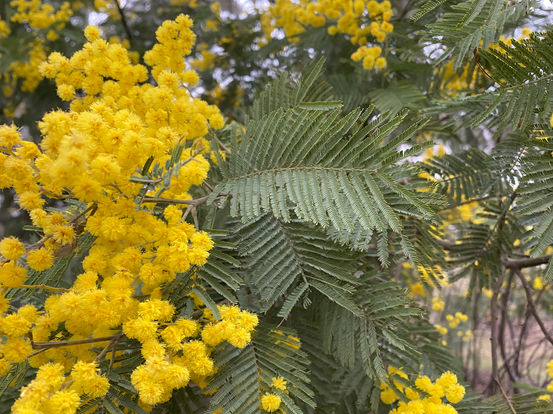
Strategic tree and forest establishment and regeneration on the Southern Tablelands
Acacia dealbata
Silver Wattle
FABACEAE
Native range: Tas, Vic, ACT, NSW Height: 4-15 m Width: 2-6 m Flowering: Late winter to spring Fruiting: Summer Light: Full sun Growth rate: Fast Soils: Will grow on most soil types Drought tolerance: High Landscape position: Lower slopes, creek margins Rainfall range: 650 – 1000 mm Benefits: Silver Wattle (Acacia dealbata) is a short-lived, native evergreen shrub to small tree, with an open canopy, highly divided, feathery, silver-grey to grey-green leaves and yellow flowers. The highly variable leaf colour is due to natural variation but can also be a sign of hybridisation with other Acacia species. Silver Wattle is known to hybridise with Cootamundra Wattle (A. baileyana), Black Wattle (A. decurrens) and Parramatta Green Wattle (A. parramattensis). The subalpine subspecies of A. dealbata subsp. alpina that has noticeably more compact, silver leaves and is found at high elevations. Silver Wattle fixes nitrogen through a mutual association with Rhizobium bacterium which cause nitrogen fixing nodules to develop on the roots. Its fast growth rate and capacity to increase soil nitrogen levels make it a good mid-level species in shelterbelts. The open canopy and form of Acacia dealbata mean it is often best suited to mixed plantings in shelterbelts, landscaping and woodlots. Although it does not create deep shade, it is a good nurse species in mixed plantings, where it protects the establishment of slower growing species without reducing light levels significantly. Acacia dealbata often suckers and forms thickets, making it a useful species for erosion control. The pollen is a valuable protein source for bees in early spring. Birds feed on seeds and insects that feed on the nitrogen-rich leaves. It one of the host plants for the Imperial Hairstreak Butterfly (Jalmenus evagoras), which is unusual in having a mutualism with ants which guard the caterpillars and pupae in return for sugar. In forest settings Sugar and Squirrel Gliders eat the gum. The timber from Silver Wattle is light- to mid-brown, with pinkish tones and attractive figuring. It is sought after by furniture makers as it has an even grain, is easy to work with, and bends and glues well. The timber makes good, fast-burning firewood. The bark is high in tannins and can be used as a dye. The flowers can be used to produce essential oils used in perfume and are used in floristry in Europe. The seeds are a delicious bushfood. Drawbacks: Suckering can be problematic in ornamental plantings. Plants can get disfiguring gall infestations. Uses: Ornamental and landscaping use in parklands and gardens Shelterbelts Erosion control Agroforestry Habitat for native biodiversity Specialty timber used in cabinetry and fine craft items Timber for firewood Bushfood Dyes and essential oils Propagation: From seed. Weed risk: Low Future climate risks: Increased suckering due to stress or post-fire effects. Increase of disease and insect attack due to uneven climate. Branch dieback. References AVH (2022). The Australasian Virtual Herbarium, Council of Heads of Australasian Herbaria, https://avh.chah.org.au Eden Botanicals - Use in perfume – https://shorturl.at/crGIM Pierce, N.N. & Nash, D.R., Biology of Australian Butterflies – https://shorturl.at/hDIX3 PlantNET (The NSW Plant Information Network System). Royal Botanic Gardens and Domain Trust, Sydney - https://shorturl.at/bdhNO The Wood Database – https://shorturl.at/qBGKY Wood Solutions – https://shorturl.at/htuvG Woolshed Thurgoona Landcare Group website – https://shorturl.at/kMS09
























